|
|
![]()
FOREST HEALTH - HARDWOOD TERMINAL FEEDERS
Terminal feeders eat buds or root tips or ends of twigs/roots. Some species in this group also do their damage by girdling twigs. Their attacks are fatal only if repeated year after year, so their real damage is in the deformities caused as a tree overgrows its injured buds. This often slows growth as well. Root insects, mostly white grubs, some borers and root weevils, are problems only in seedlings and ornamental shrubs. Entomologists suggest that many terminal insect problems could be avoided by more carefully matching planted species with the site conditions of their natural range. Most of these species are moths and beetles.
| Aphids Maple Petiole Borer Oak Twig Pruner Scale Insects White Grubs |
||
Aphids or plant lice (mostly order Hemiptera): many species, some cultivated by ants for their honeydew, honeydew on willows also attracts bees (especially in the late fall), woolly aphids have conspicuous tufts of cottony masses, aphids insert mouthparts into living plant tissue and suck out the juices, many species are colonial |
||
| Hosts: most trees, common in aspen and willows | ||
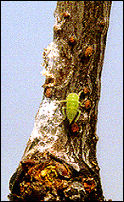 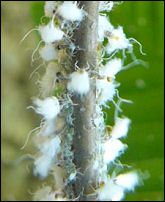 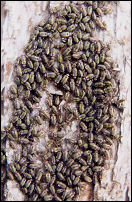 |
||
Maple petiole borer (Caulocampus acericaulis, in the beetle order): causes green maple to leaves to drop in the spring and early summer, dropped leaves are severed in their stems (petioles) |
||
| Hosts: sugar maple | ||
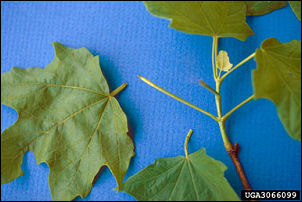 |
||
Oak twig pruner (Anelaphus villosus, a Cerambycid beetle): leafy branch ends that appear to be cut-off with a knife appear commonly in some years, newly hatched larvae burrow into and sever twigs which fall to the ground where the larvae pupates |
||
| Hosts: usually oaks, sometimes hickories, elms, walnuts | ||
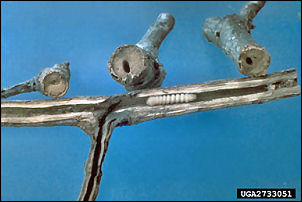 |
||
Scale insects (true bugs, several genera): small insects that form hard or soft shells, or sometimes cottony tufts on twigs or leaves, scales suck juices from trees and some have toxic saliva, black sooty mold can on twigs or on drippings below scales, mealy bugs are a kind of scale, most scales have a life stage where they become immobile while affixed to a tree, some species are exotics (beech bark disease involves a scale insect) |
||
| Hosts: many species | ||
 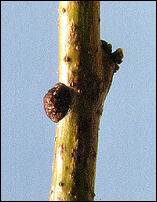 |
||
White grubs (Scarab beetles): often the larval stages of beetles (e.g. junebugs, Japanese beetles), these grubs feed on roots and can kill young trees, particularly troublesome in nurseries, an edible delicacy in some cultures |
||
| Hosts: many species | ||
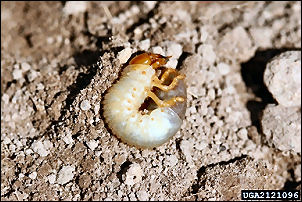 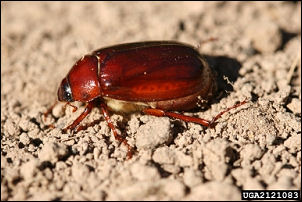 |
||
Image Citations
Maple Petiole Borer (1) - Charles D. Pless, Univesity of Tennessee, Bugwood.org
Oak Twig Pruner (1) - James Solomon, USDA Forest Service, Bugwood.org
White Grub & Junebug - Steven Katovich, USDA Forest Service, Bugwood.org
All others - Bill Cook, Michigan State University Extension
Click HERE
to return to the U.P. Tree ID home page.
Click HERE to return to the Forest Health home page.
This site created and maintained by Bill Cook, MSU Extension Forester for the Upper Peninsula of Michigan. Editing and modification is ongoing. Submit suggestions, questions, and corrections to cookwi@msu.edu or call 906-786-1575.